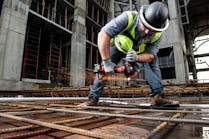What's the outlook for construction in the southeast in 2009?
Although there is great concern about the condition of construction in the southeastern states of Alabama, Florida, Georgia and Tennessee, some industry observers say that there are some areas — such as health care, education, water/wastewater, and environmental construction — which may do relatively well. However, housingcontinues to be in steep decline, and commercial construction is clearly headed down for 2009. Those sectors significantly drive other market sectors, so the picture is complex with many firms reporting smaller backlogs and few opportunities to bid for new work. On the other hand, market sectors such as military construction, public works construction, and energy-related construction may fare relatively well — depending on funding, of course. Mike Dunham of the Georgia Branch, Associated General Contractors, sounds a note of down-the-road optimism when he suggests that there may be some turnaround by the second half of 2009 as current stimulus measures "start taking hold." "But until we get to that turnaround," he adds, "it's going to be a very challenging year" with some contractors facing significant market tightening and what he calls "painful downsizing." Like others in the industry, Dunham notes that the change of administration will bring challenges in the regulatory arena. How they'll impact the industry in the southeast is still unclear, but it does add another unknown to an already uncertain future. Many feel that road work could ultimately be the engine that drives any significant turnaround. Billy Norrell of the Alabama Road Builders Association (ARBA) notes that Alabama's highway builders, like their counterparts elsewhere, are hopeful that either a stimulus package or reauthorization will provide funding. Alabama has listed 128 projects totaling $671 million on its AASHTO ready-to-go list. They could be under construction within 30 to 90 days of funding, he says — so if money shows up times could be good. Possible funding might come from a proposed $1 billion plus bond issue or from adjustments in tag fees and transportation-related tax rates. And in Florida? Although there's little local road work on the horizon, the state's highway contractors should see relatively decent lettings over the next nine to 12 months. To boost revenues, a proposal to adjust vehicle tag fees is set to go before the legislature. But cuts are impacting capacity improvement projects, and a drop-off is likely beyond 2009 unless funding can be found. It's much the same up in Tennessee. Kent Starwalt of the Tennessee Road Builders Association (TRBA) notes that the state's program "could certainly use some money." Over a ten-year period, he adds, "TDOT has about an $8 billion gap between needs andfunding." Starwalt notes that Tennessee is one of eight states with no bond indebtedness for highway transportation, but he adds that $350 million in bond authorization has been proposed by TDOT. That money would be earmarked for bridge work, he says, but he adds that there is concern over its impact on bridge work down the road. "It would yield lots of short term work," Starwalt says, "but it would bring long-term debt and does not address long-term needs." In Georgia, too, highway contractors continue to struggle with a tight market and a lack of funding. Programs such as the recently announced $110 million federal grant for conversion of HOV lanes to toll lanes on a stretch of I-85 north of Atlanta will certainly not hurt, but the key to recovery continues to be significant funding for much-needed projects around the state. The recurring theme is funding — and many are quick to point out that a strong highway program is one of the best ways to jumpstart a wide range of economic sectors. "It's going to be up to state government to try to do something positive to stimulate the economy," notes Florida Transportation Builders Association's Burleson. "A serious realization that we need transportation funding in Florida has got to hit home," he continues, "and infrastructure construction is far and away the best way government can stimulate the economy." Alabama Road Builders' Norrell echoes that sentiment. "If we have the funding," Norrell says, "one thing our industry excels at is to get projects under construction quickly." He adds, "In our industry, we can start a project and put people to work within weeks of having funding available. That turns the money around quickly and puts it right back into the economy."
Year
Transportation
Buildings
Sewer/Water
Misc. Civil
Total Hwy & Heavy
Total
2006
7,157,567,533
29,088,080,377
1,860,821,963
960,348,315
9,978,737,811
39,066,818,188
2007
6,426,813,355
30,967,319,484
3,156,832,308
792,356,097
10,376,001,760
41,343,321,244
2008
4,000,000,000
26,630,000,000
3,150,000,000
670,000,000
7,820,000,000
34,450,000,000
2009
3,240,000,000
25,220,000,000
2,590,000,000
545,000,000
6,375,000,000
31,595,000,000




